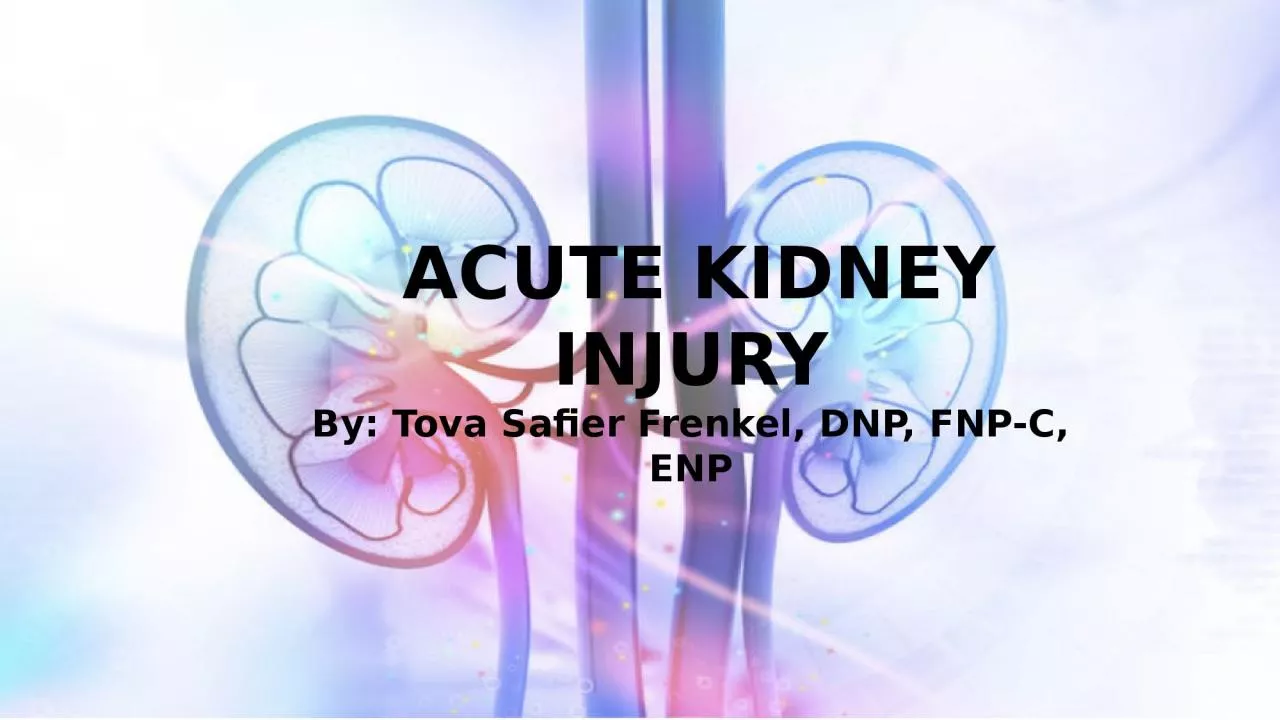

ACUTE KIDNEY INJURY Abrupt reduction in renal function over hours to days that we believe has the potential to be reversed LAB TRENDS HPI AKI VS CKD Acute Kidney Injury Chronic Kidney Disease ID: 1033033
Download Presentation The PPT/PDF document "ACUTE KIDNEY INJURY By: Tova Safier Fren..." is the property of its rightful owner. Permission is granted to download and print the materials on this web site for personal, non-commercial use only, and to display it on your personal computer provided you do not modify the materials and that you retain all copyright notices contained in the materials. By downloading content from our website, you accept the terms of this agreement.
1. ACUTE KIDNEY INJURYBy: Tova Safier Frenkel, DNP, FNP-C, ENP
2. ACUTE KIDNEY INJURYAbrupt reduction in renal function over hours to days that we believe has the potential to be reversed LAB TRENDSHPI
3. AKI VS CKDAcute Kidney InjuryChronic Kidney DiseaseOnsetSuddenGradual, often over many yearsMost Common CauseAcute Tubular NecrosisDiabetic NephropathyDiagnostic Criteria___ Serum Creatinine AND/ORAcute Reduction in Urine Output ___ GFR < 60AND/ORKidney Damage > 3 MonthsReversibilityPotentially Progressive and IrreversiblePrimary Cause of DeathInfectionCardiovascular Disease
4. CAUSES OF AKIPRE-RENALINTRA-RENALPOST-RENAL
5. PRE-RENAL FAILUREHEART FAILUREMISEPSIT SHOCKANAPHYLAXISEMBOLISM RENAL ARTERY THROMBOSISBURNSDKADEHYDRATION GI LOSSESHEMORRHAGEEXCESSIVE DIURESISCONTRIBUTES TO INTRA-RENAL FAILURE (ATN)DISTINGUISHING OLIGURIA (<400 mL/day) _____Caused by factors that reduce systemic circulation causing a reduction in renal blood flow such as decreased cardiac output, decreased peripheral vascular resistance, decreased renovascular blood flow, and hypovolemia. The decrease in blood flow leads to a ____ glomerular perfusion and filtration of the kidneys
6. INTRA-RENAL FAILUREACUTE TUBULAR NECROSISNEPHROTOXINSANTIBIOTICS (ex. Gentamicin)CONTRAST MEDIADIRECT TRAUMA/CRUSH INJURY INTRATUBULAR OBSTRUCTIONACUTE GLOMERULARNEPHRITISRHABDOMYOLYSISDEVELOPMENT OF ATN:ISCHEMIANEPHROTOXINSSEPSIS Develops as a result of prolonged pre-renal kidney injury secondary to ischemia or toxins and/or direct trauma to the kidneys and/or direct trauma to the muscles resulting in impaired nephron functionNEPHROTOXINS:CONTRAST MEDIA*NSAIDsANTIBIOTICSCall the provider is the patient takes ____ and requires a CT scan with contrast. This can cause a build up of ____
7. PATHOPHYSIOLGY: DECREASED BLOOD FLOW TO THE TUBULES HYPOXIC CELLS & NECROSIS CELLS FALL OFF & CREATE A PLUG IN THE TUBULE AN OBSTRUCTION & BACK UP OF FILTRATE DECREASES BLOOD FLOW EVEN MORE SENDS FEEDBACK WHICH INCREASES PRESSURE IN THE TUBULE SYSTEM GLOMERULUS CONSTRICTS THE AFFERENT ARTERIOLE VICIOUS CYCLE OF MORE NECROSIS & HYPOXIAURINALYSIS:MUDDY BROWN CASTS RENAL TUBULAR EPOTHELIAL CELLS TREATMENT:SUPPORTIVE MANAGEMENTIV FLUIDS STOP NEPHROTOXIC AGENTS
8. POST-RENAL FAILUREBPHKIDNEY STONEBLADDER TUMOR EXTRARENAL TUMORSREVERSIBLE IF OBSTRUCTION IS RELIEVEDInvolves the mechanical obstruction in the outflow of urine which can stem from the ureters, bladder, prostate, or urethra INTRARENAL DAMAGE IF OBSTRUCTION NOT RELIEVED
9. CLINICAL MANIFESTATIONS OF AKI
10. OLIGURIC PHASEDECREASED UO of < 400 mL/dayANURIA: URINARY TRACT OBSTRUCTIONOLIGURIA: PRE-RENAL NONOLIGURIA: ATNOCCURS: WITHIN 1 – 7 DAYS OF KIDNEY INJURYLASTS: 10 – 14 DAYSURINALYSIS: CASTS, RBCS, AND WBCSURINE SPECIFIC GRAVITY: 1.010E+ IMABALANCES:ELEVATED POTASSIUMDECREASED SODIUMMETABOLIC ACIDOSISASSESSMENT:Is & Os / DAILY WEIGHTSMENTAL STATUSTELEMETRY VITAL SIGNS (BP, RESP)Jump Start the KidneysAdminister large amounts of fluids and hope the kidneys respond which is monitored by urine outputBe aware fluid may go into the tissues and lungs watch for edema in the tissues and lungs (i.e. crackles, respiratory distress)If unable to jump start the kidneys, a temporary catheter is required for dialysis especially if potassium is elevatedElevated ____ and ____
11. DIURESIS PHASEURINARY OUTPUT 1 – 5 L/DAYDECREASED BPDECREASED SODIUMDECREASED POTASSIUMDEHYDRATIONCr & BUN START TO STABILIZE (TREND DOWNWARDS)The nephrons are still not fully functional even as urine output increasesThe high urine volume is caused by osmotic diuresis from the high urea concentration in the glomerular filtrate and the inability of the tubules to concentrate the urineIn this phase, the kidneys have recovered their ability to excrete wastes but not to concentrate the urineHypovolemia and hypotension can occur from massive fluid losses.
12. RECOVERY PHASEGFR INCREASES1 - 2 WEEKSUP TO 1 YEARSOME MAY NEVER RECOVERBegins when ____ allowing the BUN and serum creatinine levels to decrease
13. POTASSIUM EKGHYPOKALEMIAHYPERKALEMIAHypokalemia: creates the illusion that the T wave is “pushed down” T-wave flattening/inversion, ST depression, and prominent U wavesHyperkalemia: the T wave is “pulled upwards”, creating tall “tented” T waves, and stretching the remainder of the ECG P wave flattening, PR prolongation, and QRS widening
14. ELEVATED POTASSIUM - EKG
15. ELEVATED POTASSIUMTREATMENTS REGULAR INSULIN + GLUCOSE SODIUM BICARBONATE CALCIUM GLUCONATEKAYEXALATE DIETARY RESTRICTIONSALBUTEROLHEMODIALYSIS